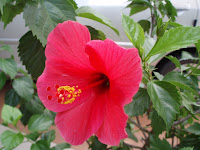About Me

- cikgubio
- My name is Poon Cheng Moh. I have been teaching biology in SMK(P) Raja Zarina, Port Klang for 26 years. I sincerely hope that this blog on SPM Biology will be useful to both teachers and students.
Sunday, July 18, 2010
Thursday, July 15, 2010
2006 Biology Paper 3 - Question 2
A housewife made fruit pickles using unripe mango. During the preparation, she placed the mango slices in water and later placed them in sugar solution.
When the mango slices were in the water, it was found that the slices became turgid and their sizes increased. But when they were placed in the sugar solution, the slices became soft and shrunken.
Based on the above situation, plan a laboratory experiment to determine the concentration of sucrose which is isotonic to the cell sap of the mango.
The planning of your experiment must include the following aspects:
-Problem statement
-Aim of investigation
-Hypothesis
-Variables
-List of apparatus and materials
-Technique used
-Experimental procedure or method
-Presentation of data
-Conclusion
Answer
1. Aim/Objective
To determine the concentration of sucrose solution that is isotonic to the cell sap of mango.
2. Problem statement
What is the concentration of sucrose solution will cause the mass of mango strip to remain unchanged?
//What is the effect of different concentrations of sucrose solution on the mass of mango strip?
3. Hypothesis
The higher the concentration of sucrose solution, the lower the mass of the mango strip.
//The mass of the mango strip is unchanged when the mango strip is placed in 5% sucrose solution.
4. Variables
Manipulated variable: Concentration of sucrose solution
Responding variable: Mass of mango strip
Fixed variable: Type of plant//volume of sucrose solution//time to immerse the mango strip//initial mass of mango strip.
5. Apparatus
Cork borer, petri dishes, weighing scales/beam balance, knife
Material
Mango, filter paper, sucrose solution 5%, 10%, 15%, distilled water
6. Technique used
Measure and record the mass of mango strip using the beam balance.
//Calculate the change in mass using formula:
Change in mass (g) = Final mass – Initial mass
7. Procedures:
1 Four petri dishes are labeled A, B, C and D.
2 Each petri dish is filled with sucrose solution as follows:
Petri dish | Sucrose solution |
A | 20 ml of distilled water |
B | 20 ml of 5% sucrose solution |
C | 20 ml of 10% sucrose solution |
D | 20 ml of 15% sucrose solution |
3 Cork borer is used to obtain five cylindrical strips of mango.
4 Mango strips are cut so that the length is 50mm each.
5 Each strip is weighed to obtain the initial mass and the results are recorded in a table.
6 Each strip is placed in the respective petri dish and is left for 30 minutes.
7 The strips are taken out and dried with filter paper.
8 The strips are weighed again to obtain the final mass.
9 The results are recorded in a table.
10 The graph of concentration of sucrose solution against the mass of the strip is plotted.
Precautions:
1. Dry the mango strips thoroughly with filter paper.
2. Use more than 5 strips and find the average mass of mango strips.
8. Presentation of data
| Concentration of sucrose solution (%) | Average initial mass of strip (g) | Average final mass of strip (g) | Change in mass of strip (g) |
| A (0%) | Table Cell | Table Cell | Table Cell |
| B (5%) | Table Cell | Table Cell | Table Cell |
| C (10%) | Table Cell | Table Cell | Table Cell |
| D (15%) | Table Cell | Table Cell | Table Cell |
Hypothesis is accepted. The higher the concentration of sucrose solution, the lower the mass of the mango strip. The mass of the mango strip is unchanged when the mango strip is placed in 5% sucrose solution.
***Note : Responding variable: Length of mango strip***
.jpg)
.jpg)

















.jpg)
.jpg)
.jpg)
.jpg)
.jpg)
.jpg)
.jpg)
.jpg)
.jpg)
.jpg)
.jpg)
.jpg)
.jpg)
.jpg)
.jpg)
.jpg)
.jpg)
.jpg)

.jpg)
.jpg)
.jpg)
.jpg)
.jpg)
.jpg)
.jpg)
.jpg)
.jpg)
.jpg)
.jpg)
.jpg)
.jpg)

.jpg)